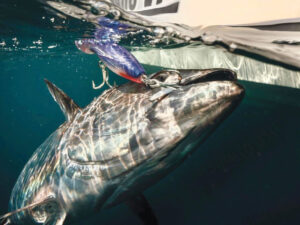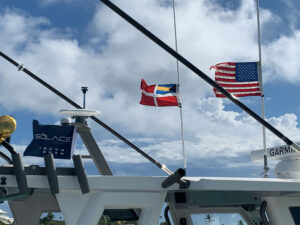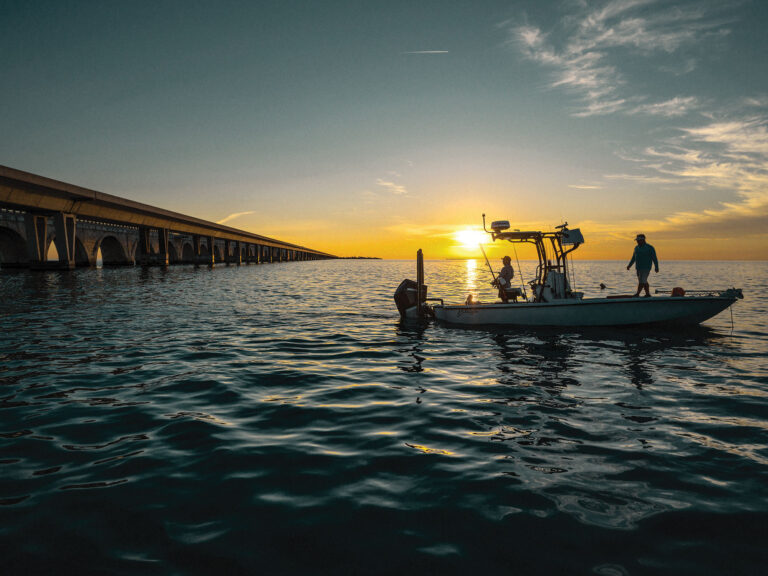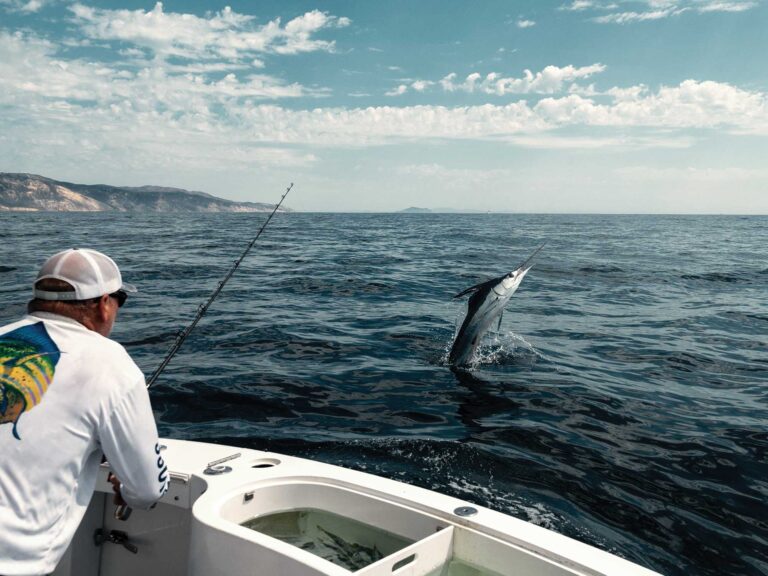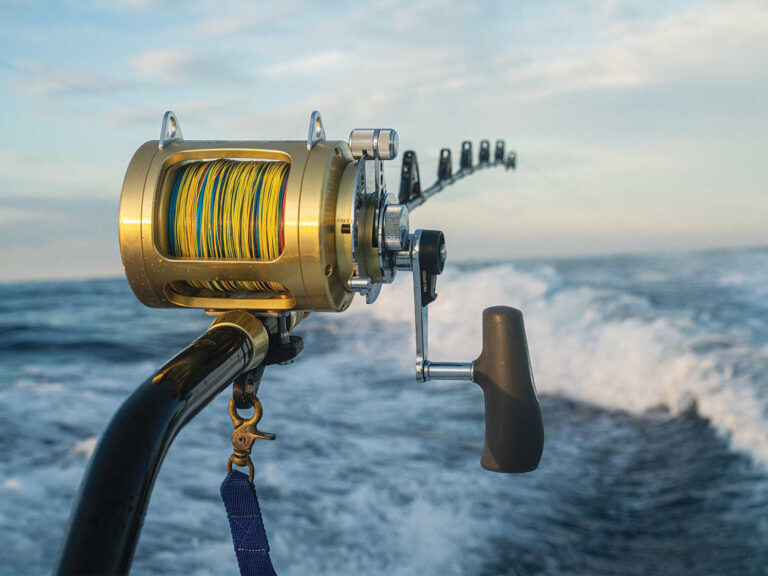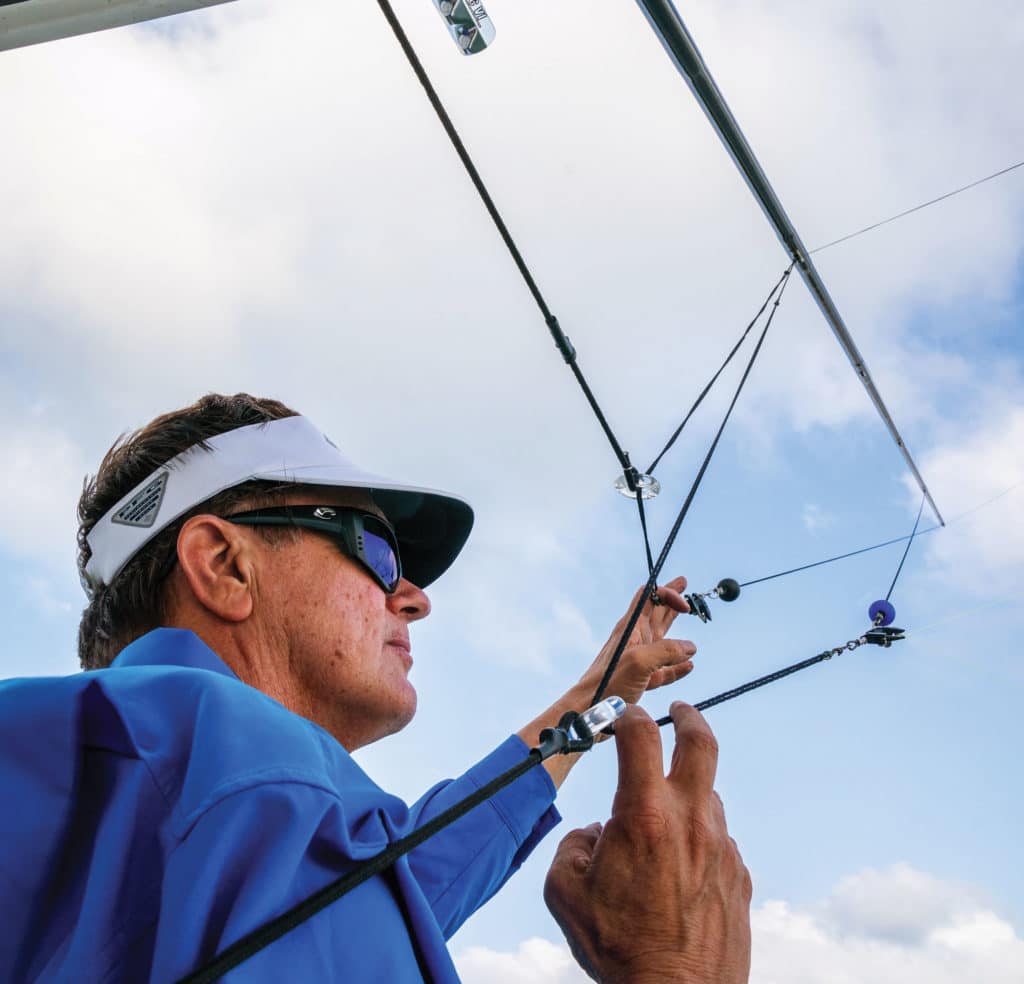
Despite the advantages of automatic drop-backs, adjustments for dialing in baits, and enabling an expanded trolling spread, outriggers—standard equipment on larger offshore fishing boats—are often unexplored options by trailer boaters and owners of midsize and large center-consoles.
Performance fishing boats racing through rough seas can take a toll on these outriggers and the T-tops upon which they are mounted. Trailering a boat with outriggers requires care to prevent halyards from tangling.
Fiber: Good For You
Major outrigger companies now offer carbon-fiber poles; while a pricier option than traditional aluminum, these lighter, stiffer poles are quieter and bounce less in rough seas, placing less stress on boat T-tops, outrigger components and the poles themselves. Internal halyards simplify securing them for trailering.

Telescoping versions eliminate leverage and bounce issues, but both one-piece and telescoping poles are light enough for one person to raise or lower. Carbon-fiber poles can be custom-built in specific lengths and rigidities, and come in a choice of colors. And they fish extremely well—trust me.
George’s Take
I opted for one-piece 20-foot poles and a 15-foot center rigger with internal halyard channels for a neater rigging appearance. Each pole is rigged to fish two baits and a teaser. With two release clips on the center rigger, I often troll one bait behind the prop wash and the other beyond the spread.
Lee’s Tackle outriggers and rod holders (leetackle.com) have been on my boats since my first Mako in 1977. The SideWinder T-top Outriggers offer five angles (zero, 15, 30, 45 and 60 degrees) for fine-tuning trolling attitudes of baits, and lying flat for clearing bridges and trailering. I chose 20-foot poles for the lateral trolling spread they provide, the rigidity to pull large lures, and for simplified trailering. (Locked flat on the T-top, the tips of the poles are even with the outboard’s lower units in the trailering position.)
I selected one-piece poles because of my offshore style, their uniform strength, and the halyards can be left intact. A couple of Velcro straps on each pole also helps keep the halyards firmly secured when trailering. The bottom line: I like the efficiency of spending less time tending to my outriggers. I want them ready to fish.
Each 20-foot pole weighs approximately 3 1/2 pounds. Raising or lowering them is an easy undertaking; one hand depresses the collar at the base while the other maneuvers the pole into position.
Strong and stiff enough to eliminate the flexing and buckling often experienced with aluminum when towing large teasers, trolling lures or baits, each pole has enough forward taper and flexibility to tow small- and medium-size baits. Should I need more flexibility for small baits and lures, I simply slacken the halyards a bit. Conversely, if I need extra stiffness, I tighten up the halyards.
“We can custom-make anything outrigger-related,” says Jimmy Marin of Lee’s Tackle. “We have solid poles as well as telescoping ones in lengths of 20, 22, 24 and 26 feet. Weight savings, ease of use and, of course, trolling performance are the benefits of carbon-fiber outriggers. We offer internal and external rigging options, smooth finishes vs. graphite weaves and, on our internally rigged CX Series of poles, a choice of 10 different colors. Expect a weight savings of 3 to 4 pounds with our longer poles. Large, outboard-powered center-consoles comprise the biggest market for our T-top-based carbon-fiber outriggers, anglers who take their offshore fishing very seriously.”

Rigging Tips
- 3/16-inch braided-nylon halyards provide the best grip for barrel-swivel adjusters.
- A plastic float or small lure head that slides freely on the halyard above the top snap swivel acts as a stop, preventing the snap swivel and release clip from jamming in the upper outrigger guide.
- At the lower end, the halyard runs through a glass ring attached to a short length of bungee ending in a snap clip. Fasten the bungee to a T-top stanchion to fish; unclip and fasten to camelback straps on the T-top to secure halyards when trailering.
Carbon Tacos
A big player on the outrigger field, Taco Marine (tacomarine.com) offers Carbon Fiber, Tele-Outrigger Twist & Lock and Pin-Locking models. Taco’s Mark Henderson fishes from a large center-console, often trailering outside his North Carolina home waters. “Our carbon-fiber outriggers are all three-piece, telescoping units,” Henderson says. “They’re designed for ease of use and top trolling performance. For instance, our Twist & Lock eliminates any pin or bolt to secure the poles to their bases; just twist and lock in the poles. Strength and durability are major assets as well, and the UV-resistant clear-coated poles are fabricated to withstand the rigors of trolling multiple baits and dredges at higher trolling speeds.”
Their 16-, 20- and 24-foot poles telescope to 7 feet, 7 feet, 11 inches, and 9 feet, respectively. “The ability to easily collapse our outriggers and store them is a big selling point,” Henderson says. “As far as keeping the halyards from tangling, the adjustable line caddy keeps them secured and ready to unfurl whenever the poles are deployed.”
Other handy features include a double swivel collar for dual baits on the 16-foot poles, and a triple swivel for pulling multiple baits on the 20- and 24-foot poles. Taco Marine’s swivel collars, incidentally, allow the rollers and fishing lines to swivel in the direction of the baits virtually friction-free.
Dredging at a Glance
The strength and stiffness of carbon-fiber outriggers present an opportunity to pull dredges from center-consoles. Running 300- or 400-pound mono line from an electric reel or heavy rod-and-reel, through a pulley fastened to the outrigger; through a sliding pulley to which the dredge is clipped, and then anchored to a solid ring clamped to the outrigger above the inboard pulley. Clip the dredge tether to this solid ring with a heavy snap swivel.

“It’s basically a block-and-tackle system that allows a dredge to be handled with far less pressure on both the dredge reel and outrigger pole,” Henderson says.
What Price Success?
Outriggers, the foundation on which gamefish-attracting illusions are built, offer more than just a means of pulling baits off to the side of a boat. Used to their full potential, they provide opportunities to fine-tune a spread based on the conditions and species sought. The strength, durability, weight savings and fishability properties of carbon-fiber outriggers might come with a stiffer price tag, yet they pair nicely with today’s faster offshore fishing machines, and enable the creation and tuning of some impressive bait spreads.
If you’re serious about your offshore trolling, they are well worth the bump in price.
More Sources
Rupp: Fixed lengths in 15 and 18 feet, and telescoping in 15, 18 and 22 feet. ruppmarine.com
Gemlux: Collapsible 18- and 22-foot poles with internal rigging; 12-foot one-piece or collapsible center rigger. gemlux.com
Tigress: Telescoping 18- or 21-foot models with internal tracking, and 8-foot center rigger. tigressoutriggers.com

